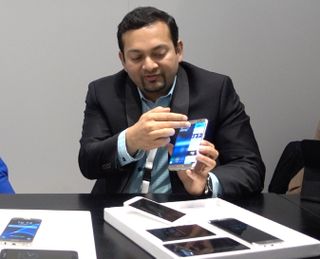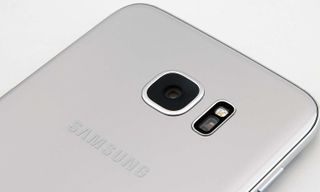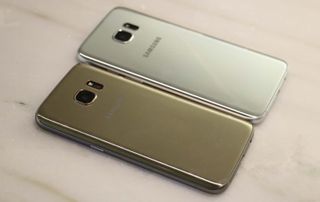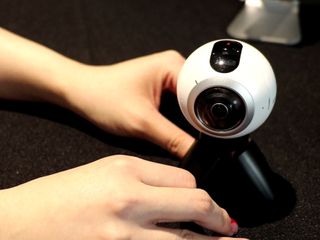Samsung: Galaxy S7 Camera Is 'Game Changing'
Samsung's Shoneel Kolhatkar explains how the Galaxy S7's new dual-pixel camera will help you take better pictures, especially in low light.
BARCELONA, Spain — If you were surprised that the camera should take such a prominent role in Samsung's Galaxy S7 and Galaxy S7 Edge unveiling this week, you shouldn't be. Cameras have long been a part of Samsung's mobile efforts.
"We were the first company to actually put a camera in a smartphone," Samsung senior director of product marketing Shoneel Kolhatkar told Tom's Guide when we sat down with him at Mobile World Congress. "We were the first company to put phase-detect autofocus in [Galaxy S5]. Now we're basically taking this to the next level where with the dual-pixel technology, it's about four times faster auto-focus in low light conditions."

The dual-pixel sensor leads the parade of changes Samsung made to the Galaxy S7 and S7 Edge. Previously limited to DSLRs — "It's only available in select professional DSLR cameras," Kolhatkar said — dual-pixel technology comes to smartphones for the first time with the S7 to take on the problem of blurry photos.
MORE: Galaxy S7 Could Be New Camera Phone King
Samsung is hardly the only phone maker to notice users' frustrations with blurry photos. A few days after the S7's unveiling, Sony showed off its new Xperia X smartphone, which will offer a predictive autofocus feature when it debuts this summer. "It's been a pain point for smartphone users," Kolhatkar agreed. "Especially in low-light conditions where... 60 to 70 percent of the pictures these days are taken.:

So how will a dual-pixel sensor save us from the heartbreak of out-of-focus photos? "What it really enables you to do is seamlessly focus," Kolhatkar said. "So even if the subject is moving continuously, if you're panning in a video, if you're panning around the room and you're changing subjects, it will quickly focus on the subject and you'll not have noticed. There's no hunting phenomenon like we've seen in smartphones."
Low-light was very much on the mind of Samsung when it came time to develop the camera for the S7 and S7 Edge. The new camera has both a larger aperture and larger pixels than before, allowing the camera to let about 95 percent more light. That should mean brighter pictures, especially in low-light situations, even though the S7's camera uses a 12-megapixel sensor compared to the 16-MP camera found in the Galaxy S6.
"The camera is definitely something we're really confident about because it's a game-changing technology," Kolhatkar said.
Galaxy S7 vs S7 Edge
Samsung also made an effort to distinguish between the two S7 models in this iteration, Kolhatkar confirmed. The most noticeable difference is size: The S7 Edge is slightly taller and wider than the S7, all the better to accommodate its larger 5.5-inch screen.

"The S7 is really targeted for someone who wants beautiful design in a really powerful form for a very pragmatic user," Kolhatkar said. "The S7 Edge adds a little more of a design-centric element to it."
That design-centric element includes a curved screen that now offers a wider area for apps and news updates, which should make the Edge screen more useful than before. That change sounds like it came from user feedback. "People would say, 'I love the Apps Edge, where I can get shortcuts to my apps from any screen.... But then I want more apps.' By widening this, I'm able to provide a lot more shortcuts, a lot more experience around this."
Sign up to get the BEST of Tom’s Guide direct to your inbox.
Upgrade your life with a daily dose of the biggest tech news, lifestyle hacks and our curated analysis. Be the first to know about cutting-edge gadgets and the hottest deals.
MORE: Galaxy S7 vs S6 vs S5: Should You Upgrade?
A Focus on Battery Life
Both the S7 and S7 Edge feature bigger batteries than their S6 counterparts — 3,000 mAh and 3,600 mAH, respectively, compared to 2,550 mAh and 2,600 mAh in the older models. But the bigger batteries only tell part of the story when it comes to improved battery life for the phones, Samsung says.
"There's a lot of innovation we have done in terms of optimizing the software, specifically using processors... that are extremely battery efficient," Kolhatkar said. "We're also using a cooling system inside the phones to make sure that the CPU and GPU are running at optimal speed and not eating up too much [power]."
Who is the Gear 360 For?
Samsung didn't just focus on the new phones this week. It also unveiled the Gear 360 camera, which uses a pair of fisheye lenses to capture high-resolution 360-degree pictures and videos. In our talk, Kolhatkar described the camera as part of Samsung's push for virtual reality. Other parts of that strategy have meant pricing the Gear HR headset at $99 to get it in the hands of more people and working with publishers to create 3D content. The Gear 360 complements that by allowing users to make VR content of their own.

So who's the Gear 360 for? We won't know who embraces the camera until it launches in the second quarter, but Kolhatkar predicts a wide appeal. "I think ultimately it will depend on the consumers and how they use it," he said. "But we have seen an interest among consumers who like to travel. They want to travel, they want to take the Gear 360 with them and really have their family and friends experience going on an Alaskan cruise with them."
Philip Michaels is a Managing Editor at Tom's Guide. He's been covering personal technology since 1999 and was in the building when Steve Jobs showed off the iPhone for the first time. He's been evaluating smartphones since that first iPhone debuted in 2007, and he's been following phone carriers and smartphone plans since 2015. He has strong opinions about Apple, the Oakland Athletics, old movies and proper butchery techniques. Follow him at @PhilipMichaels.

